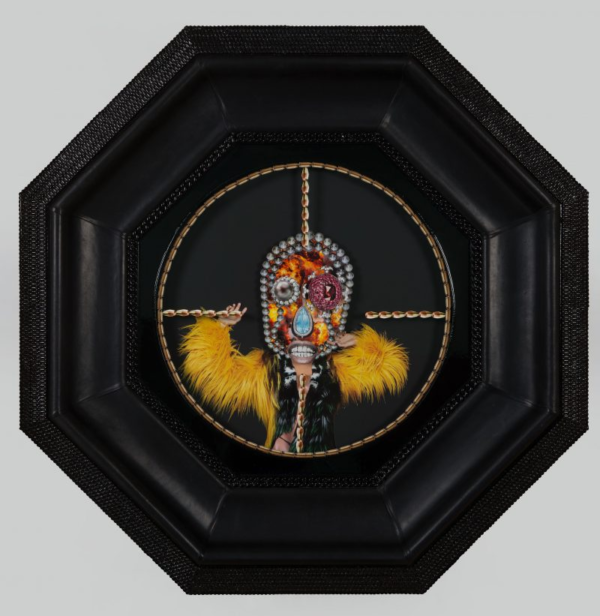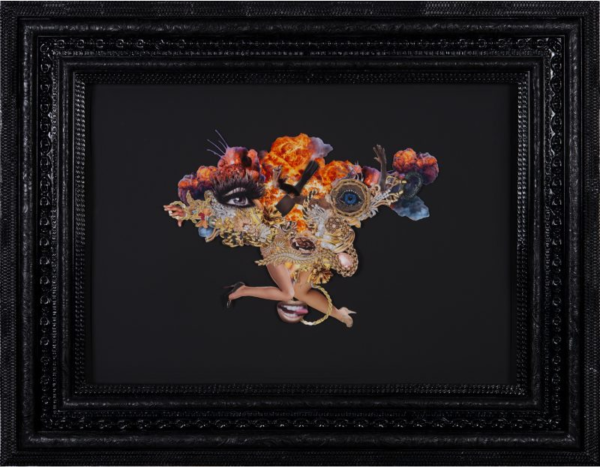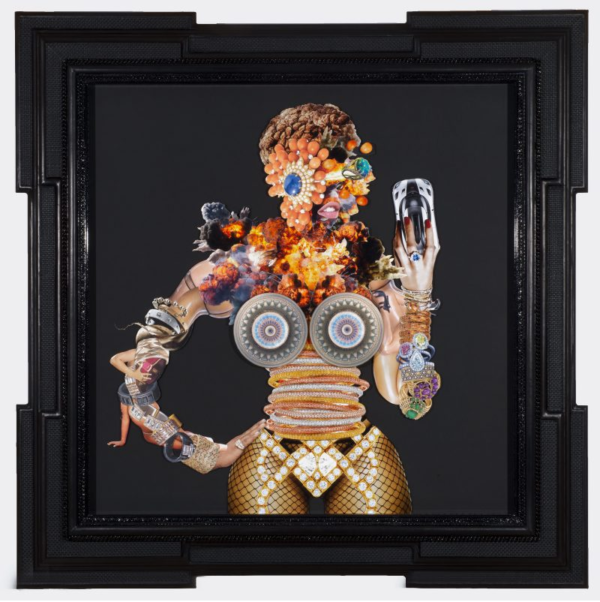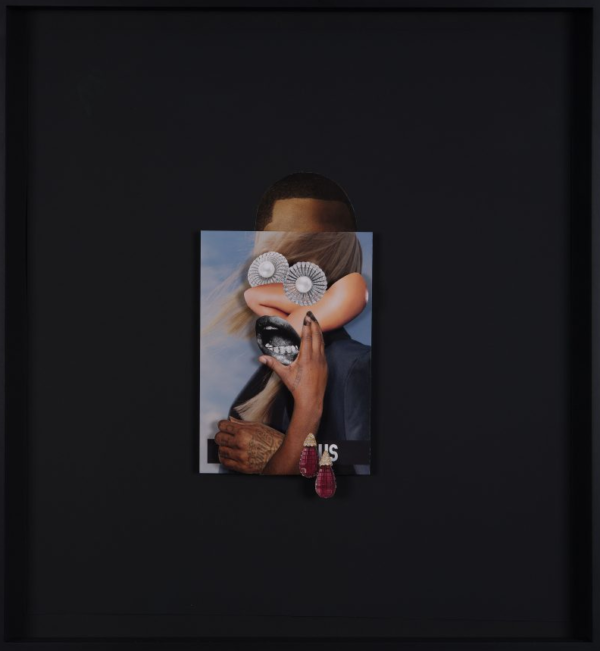It was my third day in Miami on my second annual Art Week pilgrimage. I was in the South Tent of Pulse Art Fair with my #squad, chatting in the De Buck Gallery booth with a woman named Mavis Gragg whom I’d met the evening before. We had just listened to a gallery rep give a summary and explanation of the work of Rashaad Newsome, the artist that De Buck promoted for Pulse this year. They remounted “Stop Playing In My Face!,” an exhibition that had been up earlier this year at their gallery in New York City. In it, Newsome uses collage—specifically cutouts from fashion magazines—and ornate framing to build and celebrate black female/trans bodies positioned in poses familiar to anyone who knows about the black gay ballroom scene and black American dance.

Rashaad Newsome, Hands Up, 2016
I went ahead and presumed that Newsome identified as gay. I brought up to Mavis my thoughts about work by men about women that I’d seen so far: how that the straight male gaze is, as usual, typical as fuck and the gay male gaze can sometimes be problematic. I mentioned also how in that very South Tent the previous year, I wrote about how impressed I was by the work of one Martin Gutierrez, whose conceptual series depicting the female body was most certainly NOT trite and boring. I remember spending time with “his” work, remarking to myself how sensitive and thoughtful the photographs were. Mavis had to correct me: Martin was actually Martine, and the work I had viewed last year was made before her transition.

Rosella Palma by Martin Gutierrez
My jaw really did drop, and here’s why: I pride myself on my intellectual curiosity and empathy. Yet in the hustle and bustle of my newbie experience of last year’s fairs, I didn’t think to investigate Gutierrez’ work beyond the level that I had understood it in the 15 minutes I gave it. For the past year, I’ve always thought to myself “Wow, that dude was really thoughtful,” and I never bothered to dig deeper as to why his photographs were so compelling and sympathetic. “He” had really been “she” on the inside this whole time. Not only that, she’s fierce as hell and upon further research, her work is excellent. This truth bomb made me question my initial thoughts about Rashaad Newsome’s work on view. Initial thoughts such as these:
- I love how Newsome’s work demands contemplation
- I LOVE how unapologetically sympathetic and celebratory he is of “black femaleness”
- Newsome’s sympathy with black women reminds me of Barry Jenkins’ sympathy with the mother figure in his interpretation of “Moonlight”—very nuanced and thoughtful
- Isn’t this kind of typical, though? Gay man “gathers” women together and then they are finally fabulous?
- Isn’t this a little condescending? A little patronizing? Is the subtext that black women need a man to put them back together again? Are we so broken?
So in reality, it was my own gaze that has been presumptive and problematic: I had not held up my end of the bargain as an art viewer. As a result of this self-reflection, I was left with just this one question: Does Rashaad Newsome consider (him)self a woman?
I had to ask him. Before I did though, I gave some thought to my cousin Jahmila. I didn’t meet her until I was 21, when she was still living as a gay man with a burgeoning singing and drag career in New York as YouTube sensation “Britney Houston.” I don’t pretend to be the most enlightened super-ally, but I do believe in respecting people when they tell me who they are. So when she transitioned physically to match her identity, I thought to myself, “Well good for her for living honestly; I’ll do anything I am able to support her.” And this had been the extent of my interaction with anyone trans. As a result of my realization this weekend of how presumptuous I had been though, I felt that it was important to reach out to her. I had never outright asked her if she had always felt female, if she had always viewed the world through a female lens. She responded that she had definitely felt like a girl/woman since her youth, “from …having been considered ‘just one of the girls’ at childhood slumber parties to feeling completely out of place in [male dominated/oriented spaces].” In other words, since she was a young child, and despite the doubts she felt during adolescence, she always felt more comfortable in female spaces, around female energy, and she’s always felt that energy come from within also—Jahmila’s gaze has always been female.

Rashaad Newsome, Grand Prize, 2016
This brings me back to Rashaad Newsome. If he makes his art from the perspective of a transgendered woman who has chosen not to transition to match that identity (which isn’t unheard of), then he would be just like my cousin Jahmila, only with a female gaze in a male-presenting body. I had the opportunity to speak with him during the salon hosted by his gallery back at Pulse, and we had a lovely conversation. And to cut right to the meat of it, asking him if he considers himself a woman was a little too simple a question, because in his experience he honestly sees himself as neither as male nor female, nor as gay. However, he feels that “we must acknowledge the spaces in which we exist.” And as such, he has no problem describing himself as a gay man.

Rashaad Newsome, 1stplace, 2016
I don’t think that it’s too much to ask to question your own presumptions about gender, sexuality, race, and class when you’re giving time to consider someone’s artwork, even if the work you’re viewing doesn’t explicitly address those issues. I’m leaving Miami with a pledge to halt and dig deeper when I feel myself making snap presumptions through my indifferent cis/hetero lens about artists’ views on women and femininity. This goes especially for when it’s art that I love and have no major negative critique for. Maybe you’re like me, and you’ve gotten intellectually lazy with the art and artists you like, too. If you have, then join me. There’s nothing to lose and only illuminating conversations to gain.


